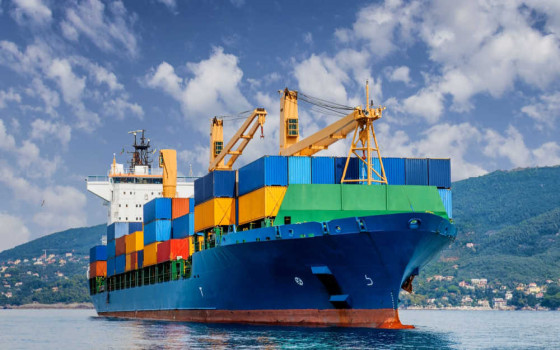
A historic agreement transforms global trade... The shipping sector enters a new era in climate action

- Europe and Arabs
- Saturday , 17 May 2025 6:35 AM GMT
New York: Europe and the Arabs
After years of neglect, the global shipping industry is taking the lead on climate change with an unprecedented agreement that is reshaping international trade. This sector, responsible for transporting approximately 90% of the world's goods, was for years considered one of the most complex and slowest to respond to the climate change crisis. But in 2025, everything changed.
Tens of thousands of giant ships cross the world's oceans every day, transporting grain, clothing, electronics, cars, and countless other products. But this vital industry comes at an additional cost. International shipping is responsible for 3% of global greenhouse gas emissions, which contribute to global warming. According to a UN News Bulletin we received this morning, which added, "For years, shipping emissions were a complex and often deferred topic in international climate discussions. But that changed in April 2025 when members of the International Maritime Organization (IMO), the UN body that oversees global shipping regulations, agreed on a historic plan to make the shipping sector net-zero by around mid-century. Net-zero is the term used to describe the balance between carbon emitted into the atmosphere and carbon removed from it. In an interview with UN News, IMO Secretary-General Arsenio Dominguez said the agreement "demonstrates that multilateralism and the United Nations remain relevant and necessary in these challenging times." Addressing the tense, and often emotional, negotiations at the 83rd session of the Marine Environment Protection Committee, he described the agreement as a commitment by the IMO and the shipping industry to combat climate change. The agreement, dubbed the "IMO Net-Zero Framework," was the culmination of years of painstaking negotiations between nations. Members, including small island states vulnerable to rising sea levels and the world's largest shipping nations.
Dominguez said he worked closely with delegates from all countries and emphasized that the collaborative approach "of seeing all member states come together and join forces to complete this agreement is something I will always remember."
A major achievement that took years
The 2025 milestone did not happen overnight. The IMO has been working to address emissions for more than a decade.
In 2011, it launched the first mandatory energy efficiency measures for ships, and in 2018, member states agreed on the organization's initial strategy for reducing greenhouse gas emissions from ships, setting the first international targets for mitigating the sector's climate impact.
Building on this progress, the organization strengthened its ambitions for 2023 and set clear targets, including reducing emissions by at least 20% by 2030 and 70% by 2040, and gradually using zero- or near-zero-emission fuels.
And it transforms The IMO's Net Zero Framework translates these plans into binding regulations. In this context, Mr. Dominguez said the focus is first on achieving a target of reducing emissions by at least 20% by 2030 and achieving a 5% share of alternative fuel use, "because that will pave the way for the next set of actions and clarify the mechanisms or other measures we need to implement."
Global Trade Mechanism
The agreement goes beyond environmental benefits; it will impact the global trade mechanism itself. In 2023, maritime trade exceeded 12 billion tons of goods, according to UN data.
Mr. Dominguez commented: "Even the chair you're sitting on right now was probably transported by ship. Ships transport things because they are the most efficient means of mass transportation. But this comes with some responsibility and some drawbacks.
Although the shipping sector has been slow to regulate its climate impact, the framework changes that through two key measures, including a global fuel standard to reduce greenhouse gas intensity and a pricing mechanism for ships that exceed emission thresholds.
Polluters will be required to purchase "remediation units" or offset their excess emissions by investing in the IMO's Net Zero Emissions Fund. Ships that adopt zero- or near-zero-emission technologies can earn excess credits, incentivizing them to reduce their emissions.
A shipowner who exceeds their emission limit can also purchase credits from another ship that has exceeded its targets or contribute to the fund.
The fund's revenues will be used to reward low-emission ships and assist developing countries with capacity building, technology transfer, and access to alternative fuels.
According to Dominguez, oversight by member states and the IMO will ensure accountability for the new measures. He emphasized that the organization is working with member states, "particularly small island developing states and least developed countries, to promote the implementation of IMO instruments."
He said. Certification, verification, auditing, and reporting processes will monitor compliance with the framework, and "everything will be reported to the organization, and then we will take further action."
These measures will include large ocean-going vessels exceeding 5,000 gross tonnage, which are responsible for approximately 85% of the sector's emissions.
Regarding the potential impacts on supply chains and costs to consumers, particularly for countries that rely heavily on imports, Mr. Dominguez emphasized that the organization has conducted a comprehensive impact assessment.
He said: "There is a price to be paid for decarbonization and environmental protection. Polluting the environment also has a price. So, all these rules, of course, will have an impact. What we have focused on is limiting that impact as much as possible. And if there is an impact, fiscal measures and pricing mechanisms will support the sector's transformation."
Innovation will play a key role in transforming the sector, and some promising technologies include ammonia and hydrogen fuels, wind propulsion, solar-assisted shipping, and onboard carbon capture.
The IMO Secretary-General said the rules were designed "to promote innovation, not to limit it." He added: "We are rediscovering the presence of wind power in the shipping industry, if I may say so... We have to be open to everything, and there is a lot of work being done in the field of alternative fuels."
He warned that this transformation will also require investment in seafarer training and safety measures, along with the adoption of alternative fuel sources. "We have to be extremely concerned when it comes to human beings," he added. "A Progressive Approach"
Mr. Dominguez said the goal is to decarbonize and reach net zero by around 2050, "but that doesn't mean we're not doing anything right now," emphasizing that it is a "progressive approach" and that the first year of compliance will be 2028.
He highlighted the IMO's commitment to continually reviewing and improving its work, saying: "For us, it's not just about the next step, but it will be a continuous process of analysis, review, and engagement to gather the expertise and skills needed to adjust or provide any additional support that may be required."
Impacts Beyond Emissions
While greenhouse gases dominate the headlines, the Secretary-General explained that shipping's environmental footprint goes beyond carbon dioxide, emphasizing that "there's a lot more this organization is doing."
He said the organization's actions address issues such as biofouling—the buildup of aquatic organisms such as algae and barnacles on ships' hulls that increases drag and fuel consumption; underwater noise, which can affect marine life; and ballast water management, which prevents the spread of invasive species across the globe. He added, "We always take into account that ships touch many parts of the environment, and we must protect them."
The Way Forward
Mr. Dominguez told UN News he was confident the framework would be adopted at the IMO's special session in October "because we have just demonstrated that multilateralism still matters, and that the IMO is ready to deliver on its commitments."
He explained that the next step would be to address concerns and develop guidelines for implementing the new measures, including the pricing mechanism.
He said, "This will help us meet the very ambitious timeframe that Member States have committed to, so that, once these amendments enter into force in 2027, we can begin to demonstrate with tangible results what the shipping industry means when it talks about decarbonization."
Mr. Dominguez and many observers see the agreement as a rare victory for multilateralism and a new beginning for a critical sector. "It's not a matter of whether we are doing it right, but that we are doing it right," he said. "This is a transitional process, and we are now taking the first steps that will lead us to the main goal."












No Comments Found